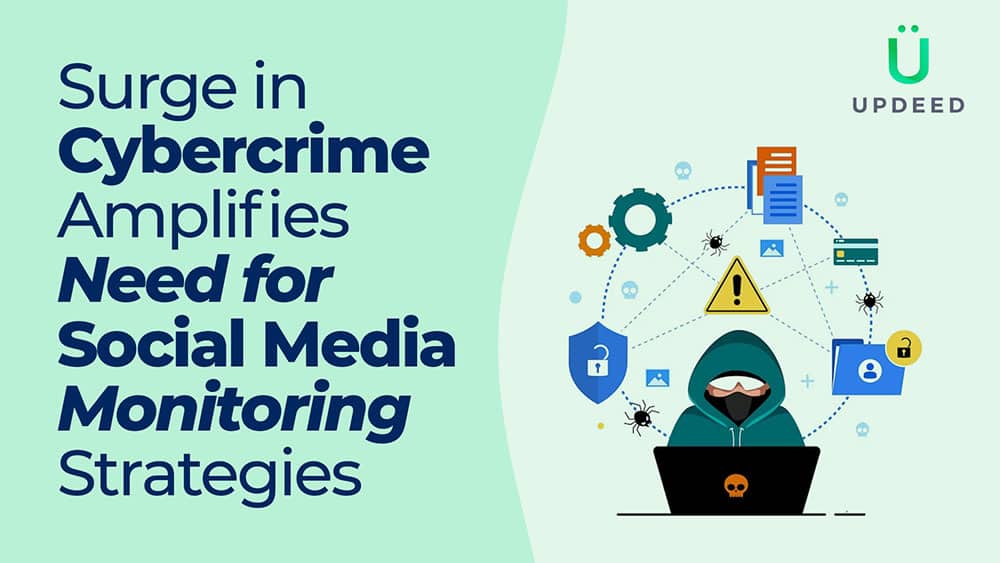Surge in Cybercrime Amplifies Need for Social Media Monitoring Strategies
In light of the increasing occurrences of cybercrime and the widespread utilisation of social media as a platform for criminal activities, one of the State governments of India – Andhra Pradesh, is deliberating on establishing a social media monitoring centre.
Currently, the concept is in its early stages, and several matters are being addressed, such as
engaging in discussions with service providers, different companies responsible for operating social media platforms, and, notably, assessing its legal boundaries of operation.

In today’s digital age, the surge in cybercrime has become a pressing concern for individuals, organisations, and governments worldwide. With the extensive use of social media platforms, cybercriminals have found new avenues to perpetrate illicit activities.
As a result, the need for effective social media monitoring strategies has become paramount. This calls to delve into the alarming rise of cybercrime and explores the various aspects surrounding the implementation of social media monitoring measures.
The Rising threat of cybercrime
The proliferation of technology and the widespread adoption of the internet have opened up numerous opportunities for cybercriminals to exploit unsuspecting victims. From identity theft and financial fraud to online harassment and data breaches, the range of cybercrimes continues to expand. According to recent statistics, cybercrime has witnessed an unprecedented surge in recent years, causing significant financial losses and compromising personal privacy globally.
With their vast user bases and interconnectedness, social media platforms have
emerged as fertile ground for cybercriminal activities. These platforms provide cybercriminals with direct communication with potential targets, making it easier for them to deceive and manipulate individuals.
Moreover, sharing personal information on social media profiles can inadvertently expose individuals to identity theft and online scams. Social media’s anonymous nature further complicates cybercriminals’ identification and prosecution.
The need for monitoring
Given the pervasive nature of cybercrime on social media, there is an urgent need for proactive monitoring and surveillance measures. Social media monitoring involves systematically tracking and analysing online activities to identify and mitigate potential threats. By closely monitoring social media platforms, law enforcement agencies, organisations, and individuals can detect suspicious behaviour, anticipate cyberattacks, and take timely action to prevent potential harm.
Governments worldwide have recognised the need to combat cybercrime and are increasingly focusing on social media monitoring as part of their cybersecurity strategies. Law enforcement agencies collaborate with social media platforms to monitor and identify potential threats. By leveraging advanced technologies like artificial intelligence and machine learning, they can
analyse large volumes of data in real-time, detecting patterns that may indicate criminal activity. These initiatives aim to enhance the capability to prevent cybercrimes, swiftly respond to incidents, and bring perpetrators to justice.
Collaboration between law enforcement agencies and social media platforms is crucial to monitor social media activities. Platforms like Facebook, Twitter, and Instagram have implemented measures to improve safety and security. They have dedicated teams that respond to reports of cybercrime, take down malicious content, and suspend accounts involved in illegal activities. Additionally, social media companies invest in sophisticated algorithms and technologies to identify and proactively remove harmful content, reducing the risk of cybercrime.
While monitoring social media is essential for combating cybercrime, it raises concerns regarding privacy and legal boundaries. Striking between monitoring activities and respecting individuals’ privacy rights is challenging. Governments and law enforcement agencies must ensure that monitoring measures adhere to legal frameworks, including obtaining proper warrants and complying with data protection regulations. Clear guidelines and robust oversight mechanisms should be in place to prevent any misuse or violation of privacy rights.
In the face of the escalating cybercrime surge, education and awareness play a crucial role in safeguarding individuals and organisations. Promoting cybersecurity awareness campaigns and providing comprehensive training on safe online practices can help individuals recognise and prevent cyber threats.
Social media platforms can also play a significant role in educating their users about potential risks, encouraging the adoption of strong passwords, enabling two-factor authentication, and being vigilant against suspicious activities.
Ways to fight
The surge in cybercrime has urgently needed robust social media monitoring strategies. As cybercriminals exploit social media platforms’ vast reach and interconnectedness, individuals, organisations, and governments must proactively safeguard themselves from evolving threats.
Collaborative efforts between law enforcement agencies and social media platforms are crucial to identify and mitigate potential risks. However, it is equally important to address privacy concerns and ensure that monitoring measures comply with legal frameworks and respect individuals’ rights.
To effectively combat cybercrime, there should be a comprehensive approach that encompasses monitoring and surveillance, cybersecurity education and awareness. Empowering individuals with knowledge about safe online
practices, recognising potential risks, and understanding how to respond to cyber threats is essential. By promoting cybersecurity education campaigns and providing training on best practices, individuals can become proactive participants in online safety.
Furthermore, social media platforms must continue investing in advanced technologies and algorithms to detect and remove malicious content promptly. Regular audits of security measures, strong user authentication mechanisms, and clear guidelines for reporting cybercrimes can help create a safer digital environment.
Governments also play a critical role in addressing the surge in cybercrime. They must allocate resources to strengthen their cybersecurity capabilities, establish specialised cybercrime units, and collaborate with international partners to combat cyber threats effectively. Legislation should be periodically reviewed and updated to keep pace with the evolving nature of cybercrime while ensuring privacy rights are protected.
In conclusion, the surge in cybercrime necessitates implementing comprehensive social media monitoring strategies. By adopting a multi-faceted approach that combines monitoring, collaboration, education, and legal safeguards, individuals and organisations can mitigate risks,
detect threats early on, and safeguard themselves from the ever-present dangers of the digital world.
Only through collective efforts can we create a secure and resilient online environment that allows us to harness the benefits of social media while minimising the risks posed by cybercriminals.
Ready to make a positive impact in the world?
UPDEED is the place for you. Our free and open platform is filled with inspiring stories from individuals and organizations who are making a difference in their communities and beyond. Connect and collaborate with like-minded individuals from around the globe on UPDEED, and discover your own potential to create meaningful change. Join our community and make a difference.





